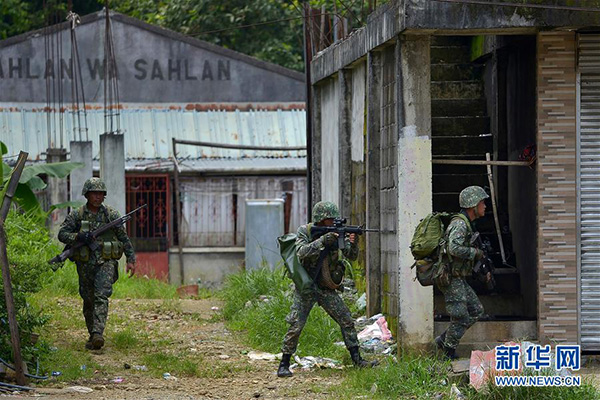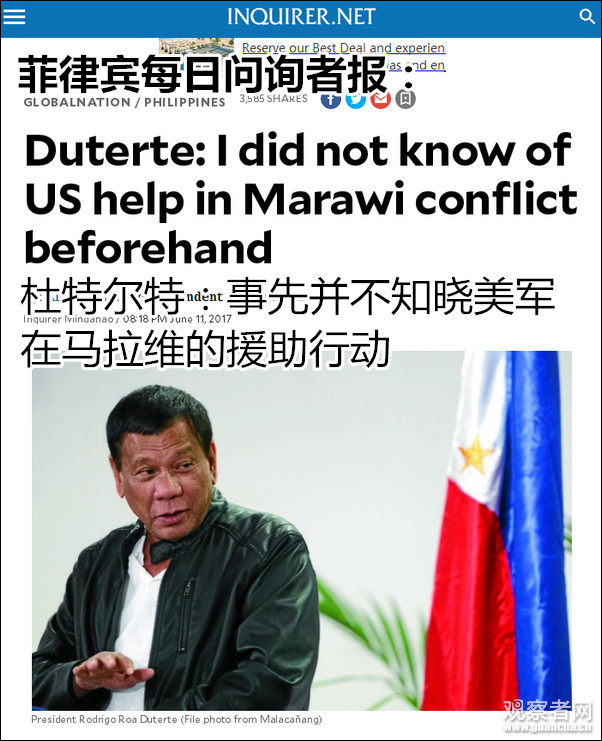Xinhua News Agency reported on June 13th that Philippine President Duterte ordered a 60-day martial law in Mindanao and other areas in the southern Philippines on May 23rd, and the country’s military and police are now fighting fiercely with the anti-government armed forces "Maute" and Abu Sayyaf, which are loyal to the extremist organization "Islamic State" (IS).
The Philippine military revealed that anti-government militants currently control 20% of Malawi, which is twice as much as the 10% mentioned last week. It seems unlikely that the government forces will end this encirclement and suppression in a short time. In addition, since the conflict broke out on May 23, the total number of casualties in Malawi conflict has exceeded 200, and tens of thousands of people have been displaced.
The rebel-controlled area of the Philippines doubled in half a month.
IS, through its propaganda agency Amaq, said that the Philippine military’s action to recover Malawi had "completely failed". It said: "IS militants currently occupy more than two-thirds of Malawi, and the military has become increasingly unable to control the situation."
Padia, a spokesman for the Philippine military, responded yesterday, calling the report by Amak News Agency "pure propaganda".

On June 3, in Malawi, Mindanao, southern Philippines, the Philippine Marine Corps searched along the street (Source: Xinhua News Agency)
Padia just said a week ago that the government forces have recovered 90% of Malawi, and 10% of the anti-government militants are in the city center.
So, how many places do IS militants control in Malawi?
For this question, the answer of West Mindanao Military Command Minister Javiz is: 20%.
He told Reuters: "Among the 96 neighboring districts in Malawi, militants control several commercial districts such as Marinao, Lulute, Mapandi and Pengolo, which account for 20% of the whole Malawi … This range is shrinking every day."
Former Commander-in-Chief of Philippine Army: Insurgents can still enter and leave Malawi at will.
The war in Malawi has entered its fourth week. Yesterday (13th) morning, guns continued to be heard in the city center, and the Philippine military constantly attacked militants with mortars and helicopter machine guns.
Malawi, a city with a majority of Muslims, originally had a population of 200,000. Most of the residents have fled since the armed elements of Ma Wude started the rebellion. The Philippine military estimates that there are still about 1,000 civilians trapped in the city.
Padia said that it is estimated that there are still about 100 militants fighting against government forces, which is much less than the initial 400 to 500 militants; However, due to the complex terrain in the downtown area where the militants are hiding, it is difficult for the government forces to attack, so it is too late to annihilate them all. "The security forces can’t fully attack because there may be civilians in the city, and the militants may use these civilians as human shields."
Biazon, former commander-in-chief of the Philippine Army, said in an interview with ABS-CBN, a Philippine TV station, on Monday (12th) that the main reason why government forces have been unable to regain control of Malawi is that the city’s borders control evacuation, and insurgents can enter and leave the city at will.
As of yesterday (13th), the war has killed 58 security forces and 26 civilians. However, Amak News Agency reported that at least 200 government troops have been killed, and many soldiers have abandoned their weapons and abandoned their posts to escape, so that militants can get weapons "supply".
The militants released prisoners to replenish their troops.
Malawi’s conflict lasted for a long time and the number of casualties exceeded expectations. Many reasons leveled the strength contrast between the two sides and escalated to a fierce battle.
Philippine government forces are not good at urban warfare, but pay attention to field operations, which are smooth with fire support, and often fall short of standards when fire support is insufficient.
Xinhua News Agency reporters have watched the joint exercises between the Philippines and the US military. The combat form is usually supported by rockets and heavy artillery, and the troops are in a state of surprise. However, in this Malawi conflict, in order to avoid causing a large number of civilian casualties, it is difficult for the Philippine government forces to use fire support such as heavy artillery, and even when using fire support, it is necessary to pay attention to prevent accidental injury to friendly troops. In the battle on June 1, the military accidentally bombed during the air raid, killing 11 government soldiers.
The militants are unscrupulous, and there are foreign armed men from Saudi Arabia, Chechnya and other regions, who are familiar with urban warfare. In addition, many members of Abu Sayyaf returned from Afghanistan and are also familiar with urban warfare.
Second, the military underestimated the number of militants. After Isnilon Hapilon and Mute occupied the prison in Malawi, they released the prisoners in the prison and got a lot of manpower to supplement them. In addition, the base of "Mute" organization is in South Lanao Province, where Malawi is located, which is very convenient for reinforcements. It is understood that Hapilon is the main leader of extremist organizations in Southeast Asian countries, and he is also the target of the State Council’s $5 million reward. At least 10 anti-government armed forces in the Philippines have formed an alliance, and Hapilon has served as the leader of the alliance.
Xinhua News Agency: There is hope for calm.
Xinhua News Agency said that although the conflict continued and caused heavy casualties, the situation in the southern Philippines was still different from that in the war-torn Middle East.
First of all,The cooperation between the two anti-government organizations and the Philippine government has made many people see the hope of resolving the conflict..
Under the government’s political offensive, the Moro National Liberation Front, as one of the two major anti-government armed forces in the southern Philippines, announced that it would send 2,000 troops to join the government forces in cracking down on Hapilon and Mute.
Another major anti-government armed force, the Moro Islamic Liberation Front, also cooperated with the government and acted as a neutral to mediate between the warring parties during the Malawi conflict.
Secondly, Xinhua News Agency reported that the Philippine military confirmed on June 10 that,The US military has been involved in the anti-terrorism operation in the Philippines.It provided "technical support and intelligence assistance" for the clean-up operations in the Philippines.

Screenshot of Philippine media reports
The Associated Press also reported on June 10th that the Philippine military had "called for help" from the US military, that the US ground troops had entered the urban area of Malawi, and that the US Navy’s P-3C patrol aircraft began to be stationed over Malawi. Mindanao, where Malawi is located, is a region with fierce ethnic and religious contradictions. Previously, the US military had deployed special forces in Mindanao for a long time to help the Philippine government control the regional situation.
However, there are still doubts about whether the US military will send ground troops. Philippine military spokesman Joe Al Herrera said at a press conference held in Malawi on the 10th that the US special forces provided "technical support" to the Philippine military, but did not participate in ground operations.
On June 6th, as part of the anti-terrorism assistance program to the Philippines, the US special forces handed over hundreds of weapons and equipment such as machine guns, pistols and grenade launchers to the Philippine Marine Corps, which also confirmed the activity of the US special forces in the southern Philippines.
In addition, the rapid rise of extremist organizations in the southern Philippines was also related to the political situation in the Philippines. At the end of former President Aquino III’s administration, the Basic Law of Bangsamoro, which was highly anticipated by many southern Muslims, failed to be passed in Congress, which angered many centrists and some moderate Muslims and led to the pursuit of armed independence of extremist organizations.
At present, the federalism promoted by the current Philippine President Duterte will give Muslims more rights and effectively attract them to adopt cooperative ways to solve problems.In view of the fact that the main forces in the southern Philippines have no action or will to intensify the conflict, it is difficult for Abu Sayyaf and Mut to fish in troubled waters and take advantage of the situation..
However, it IS worth noting that IS is increasing its investment in the southern Philippines. Indonesian Defense Minister Ryacudu said on the 4th that according to Indonesia’s information, there are about 1,200 IS members active in the Philippines.
Prevent Philippine terrorists from infiltrating Indonesia and plan to build more military bases on outlying islands.
Recently, the threat of terrorISm faced by Southeast Asian countries is increasing day by day. Countries are worried that IS, which was defeated by the United States-led Coalition forces in Iraq and Syria, may move to Southeast Asia and establish a new base in Mindanao, which will threaten the security of the whole Southeast Asia.
To this end, the Indonesian military and police have also stepped up their security alert.
According to Xinhua News Agency on the 11th, in order to prevent the infiltration of terrorists, Indonesia, a country of thousands of islands, announced on the 8th that it would build more military bases on outlying islands, including Morotai Island near Mindanao in the southern Philippines.
The Jakarta Post reported that Gato Nurman Tiyo, commander of Indonesian armed forces, said that the military would build a military base on Morotai Island in the northern part of Maluku province, aiming at preventing terrorists from fleeing into the country in the southern Philippines. He added that after the new military base is built, the equipment will be gradually transported there.
Indonesian antara News Agency quoted President Joko as saying that the construction of the military base on Morotai Island will be gradually advanced. Indonesia is building a military base on Grand Natuna Island in Riau Islands province. Zoco said: "At present, our focus is on the military base on Grand Natuna Island. After the completion of this project, we will focus on building the military base on Morotai Island."
The fuse of Malawi conflict
Xinhua News Agency reported that on May 23rd, local military and police in Malawi began to search for the leader of the anti-government organization Abu Sayyaf, Hapilon. Hapilon IS an important target on the State Council’s most wanted list and an important agent of IS in the southern Philippines.
To the surprise of the military and police, an arrest operation quickly escalated into a large-scale conflict: armed elements led by Hapilon occupied important institutions such as the municipal government, prisons, hospitals and churches, and kidnapped citizens as hostages; The Army’s 103rd Brigade barracks stationed outside Malawi were also attacked by the anti-government armed group Mute, an ally of Hapilon who had sworn allegiance to IS.
At the beginning of the conflict, militants occupied a considerable advantage, and even set up cards in the streets to intercept and kill local police. However, with the arrival of reinforcements from the Philippine government forces, the situation changed, the militants were gradually compressed into part of the city, and the exits of Malawi were blocked by government forces.
According to Philippine Defense Minister Lorenzana, the militants came from four organizations, of which 250 to 300 people participated in the war. Abu Sayyaf militants led by Hapilon are relatively capable, with 50 to 100 people; There are 80 reinforcements from two other rebels.
After 21 days of fighting, according to official statistics, 58 people were killed in government forces, 138 in militants and at least 20 civilians. At present, a small number of militants are trapped within three blocks by government forces, holding civilians hostage and dying.